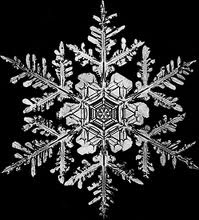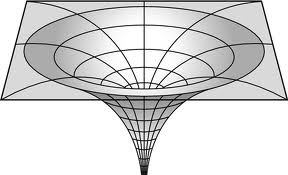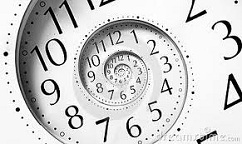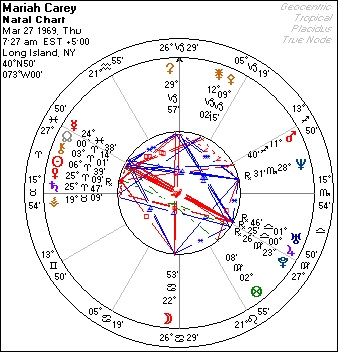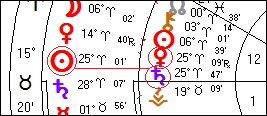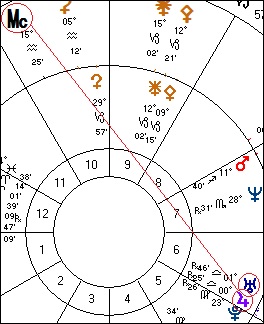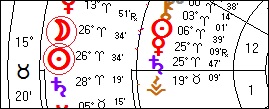Progressions are a symbolic projection of time. Astrologers use a variety of progressions, but the most common, and perhaps most useful, are called secondary progressions. The formula is that one day after birth is equivalent to one year after birth.
I like to think of progressions as fractals, where shapes have similar appearances at different scales of magnification. Since Einstein showed us that time and space are inter-related and should be considered from a single perspective, there’s no reason to assume that fractals exist merely in three-dimensional space. They exist in the four-dimensional space-time continuum.
advertisements
Progressions,
What are they?
... NeptuneCafe presents ...
“I give you a day for a year,” Ezekiel 4:5-6
Bernadette Brady
on progressions
"The progression will seem to manifest first as a feeling or need and then as an action"
"Progressions are the way the cosmos manifests through us, as compared to a transit, which manifests on us."
"Progressions are a richer source of information than transits. They tap into the realm of the inner, personal world, showing both day-to-day motivations as well as unshakable life statements or desires."
The Progressed Moon
"Chaos, or complexity theory describe show systems that are not consistently stable -- from water and cloud formations, to families, to economic and sociological trends -- exchange energy with their environments, become more complex as they change over time, and yet maintain their structural integrity.
"The astrology chart itself, particularly through the movement of the progressed Moon, can be understood in terms of these non-linear dynamic processes that occur in nature.
"The progressed Moon continually triggers patterns in the natal or progressed chart by sign, house, or by aspect. It catalyzes dynamics in the form of aspects and aspect patterns that supply external information to a system, and thereby trigger energy exchanges between all points in the system as it moves toward higher levels of complexity.
"The horoscope, which is the system, and the progressed Moon, which generates emergent processes, co-evolve patterns of development that are both constant and ever changing at the same time."
Gisele Terry, The Progressed Moon Around the Zodiac
Forecasting Using Secondary Progressions
"Secondary progressions take priority in foretelling events, since they reflect conditions for the individual at any time in question. The describe the unfolding natal potential. While the natal chart shows the influences under which a person is born and themes that will play out over a lifetime, it does not show when a particular influence or set of conditions will come about.
"It is the progressions that set the stage for potential events, showing detailed conditions and circumstances for a particular time frame according to the aspects formed between progressed and natal planets or between two progressed planets.
"The progressed aspects show the 'plot' of a story and lay the foundation for the types of events that will be triggered by transits."
Celeste Teal, Predicting Events with Astrology
The Chart Unfolds
"Each person arrives in the world with a set of talents, personality traits, and skills that can be developed. The potential is there, but it is up to each individual to develop them, while emphasizing strengths and minimizing (or resolving) weaknesses.
"The progressed chart is particularly important in this respect. It is the inner planets that differentiate the individual from the collective represented by the outer planets. Because the outer planets move so slowly, everyone born within months, and sometimes several years, has these planets within a few degrees. Not so with Mercury, for example, which moves through the entire zodiac (all twelve signs) every year. As these inner planets advance in the progressed chart, they perfect birth chart aspects, contact other planets in the birth chart (forming new aspects not in the birth chart) and change house and sign position."
"A progressed planet aspecting the natal Ascendant or Midheaven signals a major event ninety-nine percent of the time. The event usually focuses on self (Ascendant), partners (Descendant), career (Midheaven), and/or home and family (IC), and the years these events occur are generally memorable and sometimes momentous and life-changing."
Secondary Progressions and Solar Arcs
"Secondary progressions and solar arc directions are the two most commonly used methods to 'advance' the birth chart to the current year in an individual's life. They indicate current trends, the themes of the year and areas of life that will be emphasized. Both are valid predictive tools, but the majority of astrologers use secondary progressions. I prefer secondary progressions because there are generally more aspects to consider and I've found them to be more insightful than solar arcs. Simply put, I think they work better."
Kris Brandt Riske, Complete Book of Predictive Astrology
Secondary Progressions
"I find that progressions are the key to all predictive astrology. I am surprised when I lecture and travel to find that many astrologers don't use them. Without progressions the whole story is not told.
"When progressions are positive and the transits are adverse, matters can turn out in a constructive manner. However, that often is not the case when the progressions are difficult and the transits are easy."
The Progressed Sun
The Sun represents the vital force, the physical body. It has to do with power, success, ambition, energy and the ego. It has jurisdiction over the men in your life, such as the father or male authority figures and for women, their husband. Because the Sun rules the fifth house, lovers, children, sporting events, gambling, speculation, creative projects are also connected to the Sun.
"Sun progressions are going to affect you in a deep personal way and could involve any of the areas mentioned above. Wherever the Sun is placed in the natal chart is where the person can shine, where they can be a dramatic, central figure. As it progresses into other houses, there will be new emphasis placed in this area of your life."
Carol Rushman, The Art of Predictive Astrology
The Progressed Moon
The secondary progressed Moon takes about 29 years to go through all the signs of the zodiac. It is in each sign for a little over two years, which means that the natal and progressed houses it occupies during that time will gain in importance.
While the progressed Moon is in a particular sign, your life will take on a coloring of that sign. If, for example, your progressed moon is in Scorpio, you ay be dealing with the intensity of Scorpio, the need for solitude, and the need to discover that which is hidden.
A progressed Moon orb can have an effect for about three months. For example, if you have the progressed Moon conjuncting your natal Saturn, note that the effects could occur one month before the actual conjunction, and/or the month after the conjunction."
"The progressed Moon functions many times as a trigger of the progressed aspects. The house it is in, and the progressed and natal houses it rules, can all hint at an upcoming event."
"Progressions coincide with themes which then coincide with manifested events or the appropriate people coming into our lives. When the progressed moon makes aspects to certain planets, people represented by the planet and sign have an uncanny way of showing up in our lives."
Mercury, Venus, and Mars Progressions
In secondary progressions, Mercury, Venus and Mars can move into a new sign, form aspects to natal and progressed planets, go retrograde, go direct (if retrograde at birth), form progressed parallel or contraparallel positions, or become out-of-bounds by declination. Those times mark very meaningful years with events related to the nature of the planet and the sign in which it resides. Note too that when these planets move into new houses, either in the natal or progressed charts, and when they conjunct house cusps. Their aspects to natal and other progressed planets are important, and usually coincide with events around the time that the aspects are exact."
Michele Adler, Predictive Astrology
Eighteen days after Mariah was born, the Sun had advanced from early Aries to late Aries. In November 1987 her progressed Sun was at 25º Aries where it conjoined her natal Venus-Saturn conjunction. This was a once-in-a-lifetime astro-event, and it manifested as the beginning of her Cinderella-like success story.
Her progressed Midheaven describes her evolving career, and aspects to natal planets can bring success, failure or other important life events depending on the nature of the planet and aspect. In late 1987 it was at 14º Aquarius, and over the next two years as her debut album was produced and promoted, her progressed Midheaven would aspect her lucky Jupiter-Uranus conjunction (by the trioctile or 135º aspect). The sudden windfall, the overnight success promised by her Jupiter-Uranus became reality when it was activated by her progressed Midheaven.
The progressed Sun and Midheaven advance at the same rate, about one degree per year. The faster-moving Moon advances between 9 and 13 degrees per year, or about one degree per month. The progressed Moon’s aspects can be used as a timer for life’s key events. Astrologer Dane Rudhyar used the phase that the progressed Sun and Moon make to describe life’s major cycles. It begins with the progressed Sun-Moon conjunction, which is akin to the monthly New Moon. The 29-day monthly cycle in terms of the progressed cycle equals 29 years. The progressed New Moon is therefore the beginning of a 29-year life cycle.
Mariah’s progressed New Moon took place on June 23, 1989. It corresponded to the beginning of her new life as a world-renowned celebrity. Her music career took off, and in 1993 she became romantically involved with Tommy Mottola (July 14, 1949; Bronx, NY; time unknown). They married on June 5, 1993 when Mariah’s progressed Sun was at 0º25’ Taurus. The precise placement of her progressed Sun at this time is important because it was forming an exact, to-the-minute quincunx to her natal Jupiter.
The material here is an excerpt from "Mariah Carey, America's Favorite Diva" by Michael O'Reilly, which was featured in the March 2013 issue of Dell Horoscope.
Here's what published astrologers have to say about the importance of secondary progressions. Each quote is from an astrology book about prediction.
Consider Mariah Carey's Rise to Stardom...
At the age of 17 Mariah Carey left her mother and the suburbs of New York and moved to Manhattan where she hoped to get discovered. She made a four-song demo tape with a friend, and then sent it to various music labels, but was always met with failure.
In November 1987, a few months after she graduated from high school, she accompanied her friend Brenda Starr – a rising pop singer - to a record executives’ gala. She gave the tape to Tommy Mottola (the head of Columbia Records), who listened to it in his car on the way home. After hearing only the first two songs, he became so enamored by the quality of the songbird’s voice that he turned around and went back to the party, only to find that she had already left. He spent the next two weeks trying to track her down, much like the prince who found Cinderella’s shoe after the ball.
Mottola signed Mariah up, and then hired the best people in the industry to produce her first album, titled Mariah Carey. Columbia spent some $1 million to promote her debut into mainstream music. Although sales were slow at first, her appearance at the 33rd Annual Grammy Awards helped her stay on top of the charts for 11 consecutive weeks. The album eventually became a huge success. It had four singles reach #1, became the best-selling album of 1991, and by year’s end and reached sales of over $15 million.
The configuration of planets when Mariah was 18 days old will have a similar shape when she is 18 years old. One is a fractal of the other. And of course, it’s not a fixed fractal, but the patterns shift, with each element (each planet) advancing at its own rate. The most relevant progressions are the personal planets (Sun, Moon, Mercury, Venus, and Mars) and the angles, since these move at significant rates over the course of measured days. The outer planets generally move too slow to make any progress from their natal positions.

